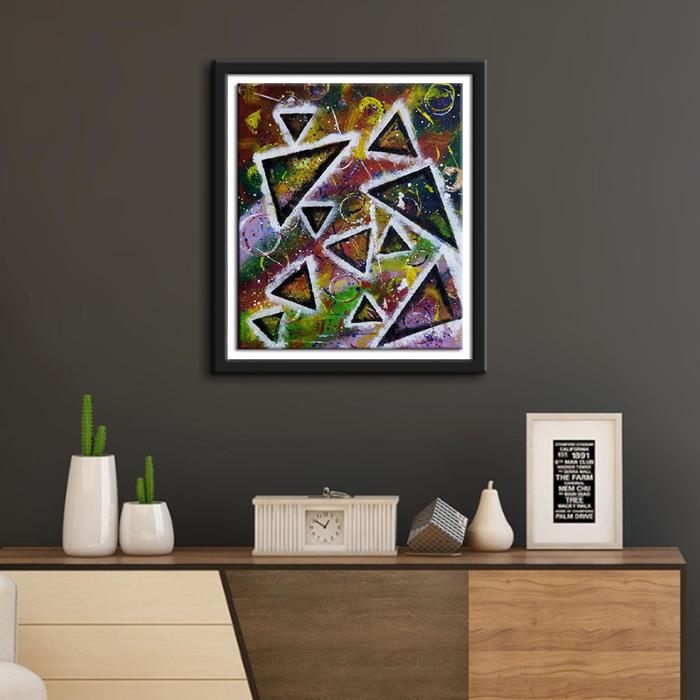Understanding Color Theory in Abstract Paintings: A Guide for Artists and Art Lovers
This article is a comprehensive guide to understanding color theory in abstract paintings. It covers various topics such as color psychology, color harmony, color symbolism, and color mixing. It is a must-have for artists and art lovers who wish to create or appreciate abstract paintings that convey certain emotions and meanings through color.
Color theory is an essential aspect of abstract art and plays a key role in the perception and interpretation of abstract imagery. Colors can evoke emotions, set moods and convey meaning in ways that words often cannot. Understanding color theory can help artists create powerful and immersive abstract paintings that resonate deeply with the viewer. In this guide, we look at the basics of color theory in abstract paintings, including color psychology, color harmony, and color symbolism.
Color Psychology
Color Psychology is the study of how colors affect human behavior and emotions. Different colors can evoke different emotions, and understanding these emotions can help artists create more impactful abstract paintings.
Color can have a direct impact on our emotions and mood, making it a powerful tool for artists to use in their abstract paintings. The emotions evoked by colors are not constant and can vary from person to person. For example, while red is often associated with passion and energy, it can also evoke feelings of anger or aggression in some people.
Understanding the psychology of color is essential for artists wishing to create abstract paintings that convey a specific mood or emotion. Artists can use color schemes to create a specific mood or atmosphere in their paintings. For example, an image that uses cool colors like blue and green can create a calming and soothing effect, while warm colors like red and yellow can create an energetic and passionate effect.
Here are some common emotions associated with different colors:
- Red: Passion, love, anger, energy
- Orange: Creativity, warmth, excitement
- Yellow: Joy, happiness, optimism
- Green: Growth, harmony, nature
- Blue: Calmness, trust, stability
- Purple: Luxury, spirituality, creativity
- Black: Power, sophistication, mystery
- White: Purity, cleanliness, innocence
Artists can use this knowledge of color psychology to create abstract paintings that convey specific emotions or moods. For example, an image with warm colors like red and orange can evoke feelings of excitement and energy, while an image with cool colors like blue and green can evoke feelings of calm and relaxation.
Abstract Paintings Color Harmony
Color Harmony is the concept of using color in a way that is aesthetically pleasing to the viewer. There are several ways to achieve color harmony in abstract paintings, including
Complementary Colors:
Complementary colors are colors that are opposite on the color wheel, such as B. red and green or blue and orange. The use of complementary colors in an abstract painting can create a bold and striking contrast that draws the viewer’s attention.
Read Also:- What Do You Mean by CEIR, IMEI Verification
Analogous colors:
Analogous colors are colors that are adjacent to each other on the color wheel, such as blue, green, and yellow. Using analogous colors in an abstract painting can create a harmonious and cohesive color scheme that feels balanced and calming.
Monochromatic colors:
Monochromatic colors are different shades and tints of a single color. Using monochromatic colors in an abstract painting can create a sense of unity and coherence.
Color Symbolism
Color symbolism is the use of colors to represent abstract ideas or concepts.Different cultures and societies have different associations with color, so the meaning of colors can vary depending on the context.
Also, Explore Acrylic Paintings on Canvas
Here are some common color associations:
- Red: Love, passion, danger
- Yellow: Happiness, optimism, caution
- Blue: Trust, stability, sadness
- Green: Nature, growth, envy
- Purple: Royalty, luxury, spirituality
- Black: Power, sophistication, mourning
- White: Purity, innocence, peace
In their abstract paintings, artists can use color symbolism to convey particular concepts or themes. A painting with a lot of red, for instance, might represent love or passion, while a painting with a lot of black, for instance, might represent strength or sophistication.
Finally, mastering color theory is necessary for producing powerful and captivating abstract paintings. Paintings can evoke feelings, convey meaning, and connect with viewers deeply when artists use color psychology, colour harmony, and colour symbolism. Understanding color theory can improve your appreciation and understanding of abstract art, whether you are an artist or just a fan of the visual arts.
Also, Read: 10 Home Improvement Tips For The Value of Your Home











